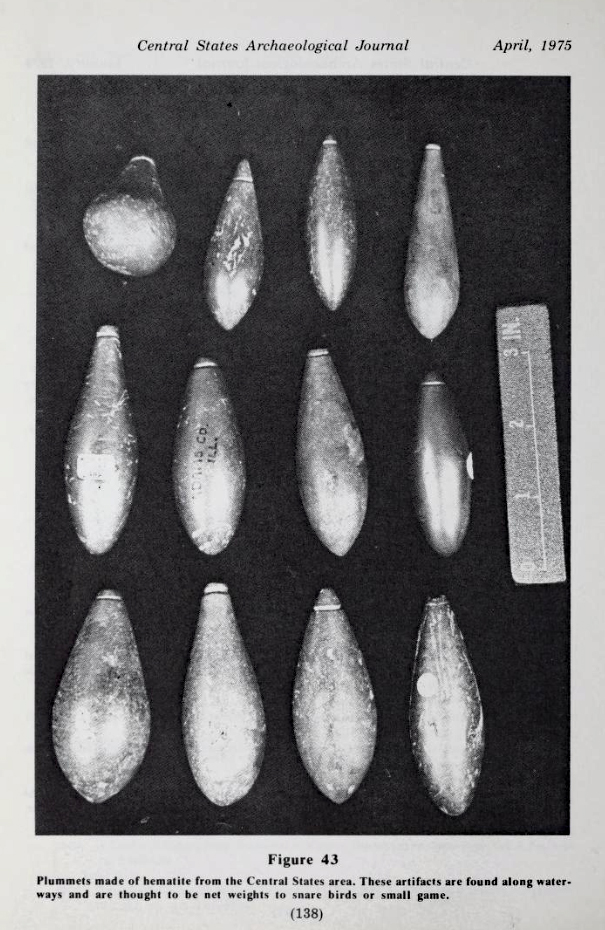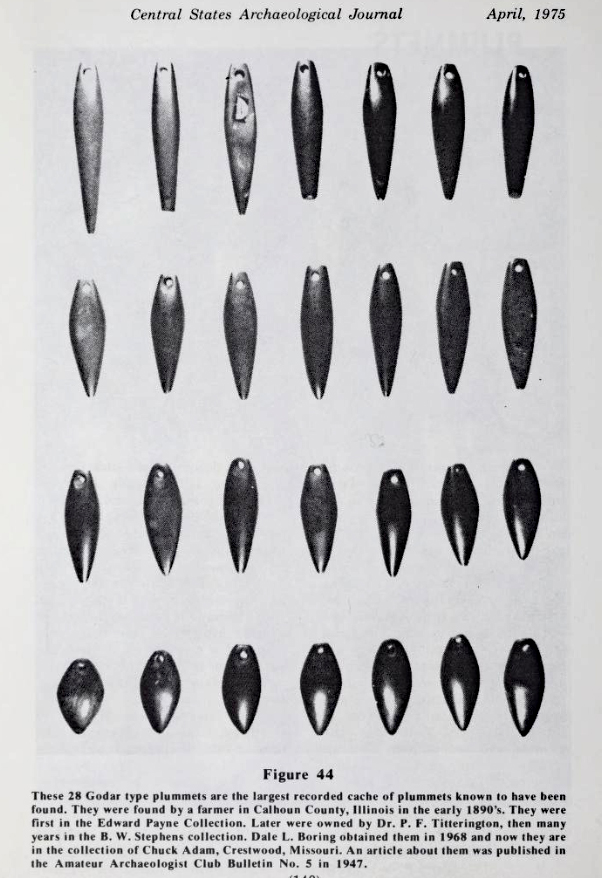By Ben Thompson
Kirkwood MO.
Reprinted from the Central States Archaeological Journal April 1975
Why such a name? The name plummet is applied because of the similarity of many specimens to the builder’s plummet. The plummet can be described as a plum-bob or tear-drop shaped stone used as a bolo, or throwing weapon attached to the end of a thong or cord. The shapes are greatly diversified. Plummets range in size from less than one inch to six inches in length and can weigh up to one pound. They are made of various materials such as hematite, granite, limestone, shell, slate, galena, steatite, copper, and pyrite. The most common type in the Mississippi Valley is the hematite grooved plummet, shown in the accompanying picture. Numerous specimens are roughly shaped, but most are very symmetrical and highly polished, often very graceful in contour. Occasionally they are engraved or carved with designs (Reference Vol. 21, No. 3, pg 107, Perino). Eccentric forms are sometime found. Crescent shapes have been found in Florida. I have one hematite crescent-shaped plummet in my collection, and other odd shapes also (see photo). In California they tend to be longer and sometimes have a knob on both ends. Some plummets found in Florida are made from the center whorl of a conch shell. I have one example of this type that was found near Cahokia, undoubtably a trade item.

The late William Waters of Goedfrey, Illinois, had a collection of over 1600 plummets, mostly from the St. Louis area. This was the largest collection of plummets ever gathered together. Approximately 80% of these were made of hematite. Others were made of various materials, but it seems the high density of hematite was the most desirable. This leads one to think that their weight was beneficial in their use. Many theories exist as to their possible use, but most probably they were used with a net to snare birds, possibly water fowl. One was found by Clarence Moore in a mound in Bravard County, Florida, with the top carved like the head of a duck. This indicates that they could have been used to net ducks. The one that Mr. Moore found was with a cache of eleven plain grooved ones.

Consider this, in prehistoric times wildlife, including waterfowl, was much more plentiful than it is now. I can remember my grandfather telling me he saw carrier pigeons flying over in such large numbers that they darkened the sky like a cloud. They were not afraid and flew close overhead. It was an easy matter to kill them, and the white man did just that, to the point that today carrier pigeons are extinct. It is very likely waterfowl were just as plentiful for the Indians, and with a little practice the plummet could be thrown with its entangling lines or net to trap the unwary birds. It was much better for the Indian to catch his game and keep it alive until time to butcher it because of the lack of refrigeration.

Most plummets have a small, sometimes very slight, groove around the top for suspension. About one out of thirty have a hole for suspension. Of course, it was much more difficult to drill a hole than it was to carve a groove around the top. Some have two or more grooves encircling the top. Often, they are neither grooved nor drilled, and these were probably wrapped in rawhide.

Plummets are widely distributed over the country, but the majority are found in the Mississippi Valley, Florida and California. They are very rare in the Southwest. It seems they were not used in drier, more arid regions away from the migratory routes of the waterfowl.

Some plummets were undoubtably worn as ornaments or pendants, and are often found associated with the human remains in burials. Some were found with the Indians in Southern California by the early pioneers and the Indians referred to them as charm stones, and believed the plummets endowed the owners with magic powers. These magic powers were helpful in curing the sick, producing rain, in war and the chase, and in games of chance. No doubt the original plummets were used as net sinkers, bolo weights, or bird snare weights, but in time they became luck stones or charms. It is worthy of note that most aborigines generally attribute magical powers to any object that proves its worth, or is successfully used in war, the hunt, or a game of chance.
Today plummets are one of the most rare and most desirable collector items, and I am sure if you are fortunate enough to find one, you may consider that a bit of the magic power of the plummet has been working in your favor.
We hope you enjoyed this article. We are looking for new members. If you are interested in this material and would like four Archaeological journals per year loaded with great articles such as this, please click the link to join now. https://csasi.org/subscribe_quick.htm